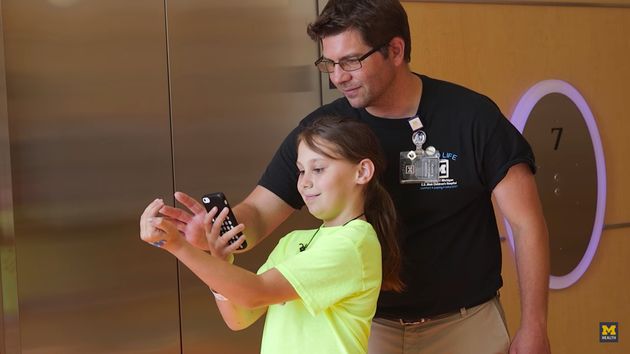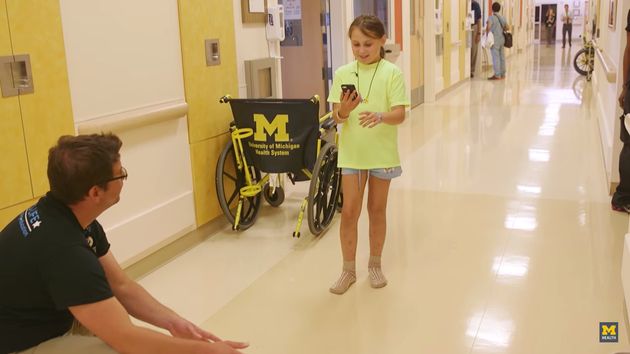Acrophobia is closely related to other two specific situational disorders, claustrophobia - marked anxiety in enclosed spaces, and aviophobia - fear of flying (Coelho,Waters,Hine &Wallis,2009). Behaviors of individual with acrophobia includes avoidance of a variety of height-related situations, including stairs, terraces, apartments and offices located in high buildings, bridges, elevators and plane trips (Coelho,Waters,Hine &Wallis,2009).
Graded exposure in-vivo is the current or traditional method of treatment for acrophobia. It is a treatment method wherein acrophobics are gradually expose to a hierarchy of feared stimuli. With this treatment, it is expected that the fear will first increase, and gradually diminished as the exposure is being repeated.
A relatively new form of treatment is the use of virtual reality to expose acrophobics to stimuli. Virtual reality integrates 3D computer-generated environments in real time (Eichenberg & Wolters, 2012). With this, it can simulate real experiences such as triggering anxiety, sweating, and nausea. For virtual reality to become as real as possible, immersion and presence are the conditions required. Immersion refers to the decreasing consciousness that the computer-generated environment is different from the real surroundings; being physically immersed results to presence (Eichenberg & Wolters, 2012). Virtual reality was first used as an application in a clinical setting on 1995 by Rothbaum and collaborators. Since then, series of researchers were conducted to test the potential effectivity of virtual reality.
In 2008, Coelho,Silva,Santos,Tichon & Wallis compared the effectiveness of real-world exposure versus virtual reality exposure of e individuals suffering from acrophobia. Participants were grouped into two, one is exposed to the real world for 50 minutes per session, while the other group is exposed to virtual reality for only 22 minutes. The experiment lasted for three weeks.
The Acrophobia Questionnaire (AQ), Attitude Towards Heights Questionnaire (ATQ), and Level of Heights Difficulty (LHD) of the participants were measured before and after the treatment. Acrophobia Questionnaire (AQ) was used to measure anxiety. Attitude Towards Heights Questionnaire (ATQ) provides the measurement for cognitive assessment and danger assessment. The Level of Heights Difficulty (LHD) is the product of the number of stairs the participant can climb, and anxiety manifested in Subjective Units of Disturbance Scale (SUDS). It was found that there is no statistical difference between the two groups before and after the therapy, meaning the two groups are identical. The posttreatment scores were compared, it was shown that both the real world group and virtual reality group showed significant improvements in all the tests.These results suggest that virtual reality exposure has the same effectivity, if not more efficient, as that of real world exposure.
The success of virtual reality exposure as a new approach to treat acrophobia offers a number of advantages over the traditional approach. Some practical benefits of the virtual reality approach are better control of the situation by the therapist; avoidance of potential public embarrassment; maintenance of confidentiality; and comfort of the protective environment of the therapist’s office.
Moreover, as virtual reality is more associated with games, it may possibly attract the interest of individuals suffering from acrophobia. They might be more willing to receive treatments due to the exciting experience of the new technological advancement.


The use of virtual reality is becoming more and more popular as a form of treatment not only for acrophobia, but also for various disorders. Another technology developed related to virtual reality is Augmented Reality (AR). Augmented reality integrates the real and virtual world by superpositioning virtual elements in the real world (Eichenberg & Wolters, 2012). This 2016, due to the popularity of Pokemon Go, a phone application that uses augmented reality, a children's hospital in Ann Arbor, Michigan encouraged their patients to play the application in order for them to exercise as well as socialize with others. It was reported that physical therapists and occupational therapists were able to let the children do the exercises when integrated with Pokemon Go.
In relation to this news, during the peak of the application's popularity, it was all over the social media that people with depression and social anxiety experience improvements upon walking around the neighborhood in order to catch Pokemon. Moreover, as the game involves walking around, it might also be a treatment for obesity.
In this day, technological advancement offers a more exciting and interesting option to treat various disorders. Development of virtual reality and augmented reality might just not be the future of gaming, but also of treatments!
In this day, technological advancement offers a more exciting and interesting option to treat various disorders. Development of virtual reality and augmented reality might just not be the future of gaming, but also of treatments!
References:
Coelho, C.M., Silva, C.F., Santos, J.A., Tichon, J., & Wallis, G (2008). Virtual and Real Environments for Acrophobia Desensitisation. PsychNology Journal, 6(2), 203 – 216. Retrieved October 23, 2016, from www.psychnology.org.
Coelho, C., Waters, A., Hine, T., & Wallis, G. (2009). The use of virtual reality in acrophobia research and treatment. Journal Of Anxiety Disorders, 23(5), 563-574. http://dx.doi.org/10.1016/j.janxdis.2009.01.014
Eichenberg, C. & Wolters, C. (2012). Virtual Realities in the Treatment of Mental Disorders: A Review of the Current State of Research. Virtual Reality In Psychological, Medical And Pedagogical Applications. http://dx.doi.org/10.5772/50094
Coelho, C., Waters, A., Hine, T., & Wallis, G. (2009). The use of virtual reality in acrophobia research and treatment. Journal Of Anxiety Disorders, 23(5), 563-574. http://dx.doi.org/10.1016/j.janxdis.2009.01.014
Eichenberg, C. & Wolters, C. (2012). Virtual Realities in the Treatment of Mental Disorders: A Review of the Current State of Research. Virtual Reality In Psychological, Medical And Pedagogical Applications. http://dx.doi.org/10.5772/50094
MacDonald, F. (2016). Pokémon Go is reportedly helping people with their depression. ScienceAlert. Retrieved 23 October 2016, from http://www.sciencealert.com/pokemon-go-is-reportedly-helping-people-with-their-depression
Wanshel, E. (2016). Hospital Uses 'Pokemon Go' To Get Kids To Do Physical Therapy. The Huffington Post. Retrieved 23 October 2016, from http://www.huffingtonpost.com/entry/cs-mott-childrens-hospital-pokemon-go_us_578e4a3de4b0a0ae97c382cb
Wanshel, E. (2016). Hospital Uses 'Pokemon Go' To Get Kids To Do Physical Therapy. The Huffington Post. Retrieved 23 October 2016, from http://www.huffingtonpost.com/entry/cs-mott-childrens-hospital-pokemon-go_us_578e4a3de4b0a0ae97c382cb





No comments:
Post a Comment